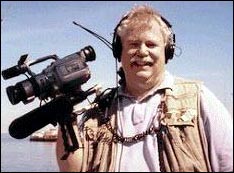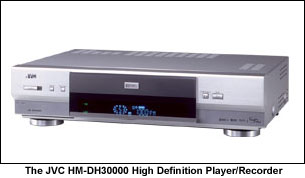Videomith
by
Steven Trent Smith
HDTV Again
|

|
Much
has happened HDTV-wise since the last issue of Digital Journalist was
published.
More Hollywood sitcom producers have jumped on the 1080/24p production
bandwagon. This may be bad news for the folks at Panavision, who are
the main supplier of 35mm motion picture cameras for these shows (which
typically use three to four cameras). Panavision saw the writing on
the wall some while ago, and made a pact with Sony to develop Panavision-style
HDTV packages using Sony's cameras.
The main reason why television producers are switching to High Def is
not because of its high definition crystal clarity. It's that most important
thing of all: money.
And ninety percent of the savings comes in shooting video tape instead
of film stock. A fifty-minute HD tape costs about $80. Fifty minutes
of 35mm film stock, developed and transferred to Standard Definition
(SD) video tape would cost in the neighborhood of $2,000. For a four
camera shoot of a thirty-minute live audience sitcom (two tapings),
HDTV media would cost less than $500, compared to well over $10,000
for 35mm. Multiply that times a twenty-show series, and you're talking
about a couple hundred thousand dollars difference.
This all means that more and more HDTV shows will be broadcast. That's
good news. That fact that HD sets still cost $3000 and up, means that
Joe and Jane Consumer aren't going to be rushing out and buying hi def
any time soon.
Another development is going to have a big, positive impact on corporate
and institutional use of HDTV.
 JVC
has introduced a high
definition player/recorder not unlike the VHS machines we all have
at home. These $2000 VCR is designed mainly for niche usersˆ the two
million technophiles who have invested in first-generation HD. Film
producers like Fox, DreamWorks SK and Universal have agreed to release
films on this new format. JVC
has introduced a high
definition player/recorder not unlike the VHS machines we all have
at home. These $2000 VCR is designed mainly for niche usersˆ the two
million technophiles who have invested in first-generation HD. Film
producers like Fox, DreamWorks SK and Universal have agreed to release
films on this new format.
The machine, the HM-DH30000 (that's right, thirty thousand), uses MPEG-2
to work its wonders. It comes with its own built-in decoder, and because
the device really only records zeros and ones, it can also record any
type of HD, SD, digital or analogue signal. It can compress eight hours
of HD on a tape, or twenty-four hours of SD.
Until the HM-DH30000 came along, a pharmaceutical company that wanted
to display the roll-out of their latest drug in HDTV had to use a $60,000
deck, or, if the program was not too long, a $10,000 file server. Now,
they can use the $2000 VCR. HDTV has suddenly gotten affordable.
In the not too distant future, HD will be available on some sort of
DVD-style disk. That will bring the cost way down, and take the mobility
way up. But it may also be four or five years down the pike. The JVC
fills that gap nicely for the time being. And if JVC did it, you can
be sure Panasonic and Sony will not be far behind (though with non-compatible
formats, for the two companies hate one another).
It's going to be a good while before we see HDTV in "mini"
form (like miniDV). But it will come.
©
2001 Steven Trent Smith
http://www.videosmith.com
|